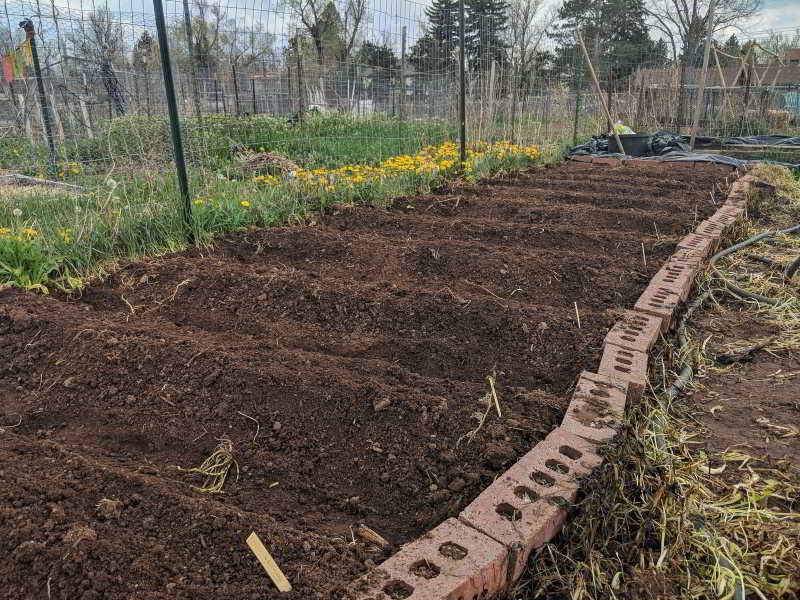Planting this garden has been giving me a huge amount of anxiety. I’ve managed my little indoor garden for several years and it has been easy enough. I start it in the winter, overplant everything, enjoy some greens and herbs and then, once summer starts in earnest, I get called off on a fire and ninety percent of it dies while I’m gone. I know that I can manage that tiny little garden pretty well and get a small quantity of produce from it, but this community garden plot is really changing the game. Suddenly I have four hundred square feet to cultivate. That’s about thirty three times as much as my tiny little shelf garden and I don’t honestly have the faintest idea what I’m doing.
To get ready for the season I brushed up on my favorite gardening books like Sufficient and The Urban Homestead and I picked up and subsequently blasted through a new one that contained way more information than I needed: The Market Gardener. This is my solution to pretty much everything in life. I am not a particularly social person, so I fumble my way through with the help of books.
There was a lot of useful information in The Market Gardener, but those folks are cultivating hundred foot long beds using a bit of heavy equipment, so it is not exactly what I have going on. I think my entire plot is about twenty five feet by sixteen feet, split into two beds, with a path down the middle and a raised bed on the south end. We are definitely not operating on the same scale here.
On top of that, the seeds that I started indoors mostly did not do very well. I definitely started some of them too early and lost some to overwatering and stagnant air, but even the healthiest among them look pretty stunted. I am not sure what I am doing wrong here, but I am filled with envy when I see pictures on instagram of trays of perfect little starters.

All these things added up to give me a huge amount of anxiety going into planting. I ended up kind of winging it. I did what felt natural for the garden and we’ll see how it turns out. Might need to call an audible mid-season and try something different for late-season crops. But here’s how it went.
Last week we had what will hopefully be the last cold weather of the season. It never got colder than high thirties, so frost wasn’t a concern, and it brought with it a few days of rain. I am not sure this is true, but it seems to me like seeds germinate best when they are warmed after a few days out in the cold, so this seemed like the perfect time to plant.
Despite the lack of frost I was still hesitant to put my delicate little seedlings out there for three days of cold rain, so I direct-seeded everything and will hold the seedlings back to fill in where needed. This might be a stupid plan, but I didn’t want to risk losing all of them and I assume there will be a few places with less than perfect germination, so I can drop these advanced plants in those spots once they present themselves.
I went to the plot and pulled up my plastic sheeting. It did a pretty good job. The garden path not under the plastic was still a mess of tall grass and weeds in advanced stages of growth, but the thick vegetation under the tarp was dead and rotting. This was a lot easier and more effective than trying to remove all that biomass manually, so I moved the plastic to cover the rest of the path and hopefully eliminate my path issues (once I throw a bit of mulch on the now bare ground). As for the weeds, I think it was pretty effective there as well. A number of seeds germinated and some things that I didn’t properly eliminate managed to re-root and sprout, but when I pulled back the tarp they were there as a handful of neon yellow shoots. It was very easy to locate them and hoe them down or pull them up.

As for the planting, I ended up putting everything in in raised rows. I wanted to plant a wide variety of vegetables in short rows, and this felt natural. The advantages that I see to the raised rows are that weeding should be fairly easy, the short rows allowed me to minimize the adjacency of plants from the same families which should help with disease and pest control, and the furrows between the rows should allow for good runoff and drainage, which is a matter of concern for a clay-heavy soil.

The biggest downsides I see are that at least right now there is a lot of exposed soil which could lead to too much heat, the rows are fairly tall which could lead to the plants having trouble getting enough water, and the rows are perhaps too close together.
But hey, we’ll see what happens. In the words of James Russell Lowell, “One thorn of experience is worth a whole wilderness of warning.”

